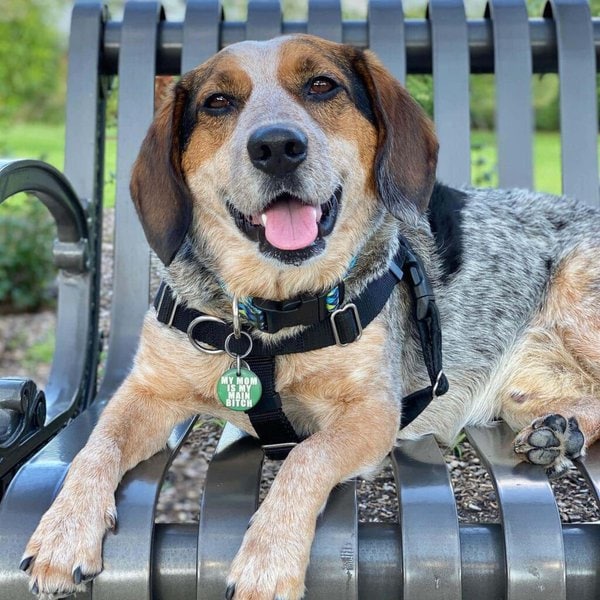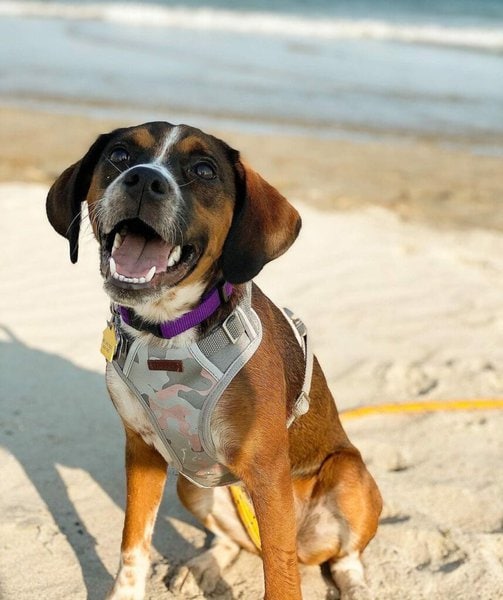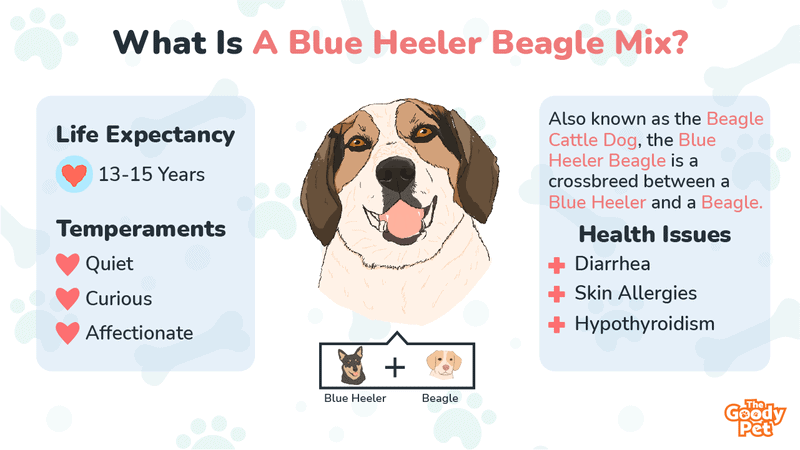Are you thinking about bringing home a Beagle Cattle dog and want to learn more about these furry babies? If so, then get ready, as we are going to provide you with complete details regarding Blue Heeler Beagle Mix.
Also known as the Beagle Cattle Dog, the Blue Heeler Beagle is a crossbreed between a Blue Heeler and a Beagle. These canines possess the dominant characteristics of their parents, such as intelligence and friendliness. Therefore, Beagle Cattle Dogs prove to be the ultimate family dog if properly taken care of.
We will help you take better care of your precious pup. In this article, you’ll get to know about the Beagle Cattle’s lifespan and how to pamper them to increase their life expectancy. Moreover, you’ll understand your furry buddy’s temperaments and pick up some grooming tips. But before that, let’s have a look at the size and appearance of the Blue Heeler Beagle Mix.
How Big Will A Beagle Blue Heeler Mix Get?
The Beagle Blue Heeler mix can grow up to 20 inches and weigh up to 45 lbs. They are of the same size as their parents, i.e., medium-sized. We will get into the details of these pups’ height and weight but first, let’s check out how they look!
Appearance
Due to both Beagle and Blue Heeler’s distinct appearances, you must be wondering what the mix of both breeds will look like. Well, the typical Beagle Heeler mix has pricked ears with the coat of a Blue Heeler and the physical appearance of a Beagle.
However, the appearance of every puppy of this breed is different. Some pups have a higher resemblance to Blue Heelers, while some are more identical to Beagles.
Alternative Name
As these dogs are named according to their breed, you must be thinking about what a blue Heeler Beagle mix is called in general. The Blue Heeler Beagle mix is commonly called the Beagle Cattle Dog.
Size And Weight
The Beagle is typically around 15 inches, but the Blue Heeler’s height of 20 inches dominates this breed. Hence, the Blue Heeler Beagle Mix can grow up to 13 to 20 inches maximum. Similarly, these pups weigh around 30 to 45 lbs. So, you can conveniently keep these furry babies in your house.
Fur Coat
Beagle Cattle dogs have heavy and thick coats similar to their parents. So, you will have to spend some time grooming them, which we will discuss further. Moreover, they have dotted or marked coats with colors varying from blue, brown, black, white, and even red.

How Long Do Blue Heeler Beagle Mixes Live?
The Blue Heeler Beagle mixes have a lifespan of 13 to 15 years.
However, to let your precious pup live its life to the fullest, you must be aware of some common health issues. For your convenience, we have listed some of them below.
Eye Infections
Beagle Cattle dogs are prone to several eye diseases with age. This breed commonly suffers from the following eye problems.
- Cataracts
- Progressive Retinal Atrophy (PRA)
- Primary Glaucoma
- Secondary Glaucoma
Although most eye problems are mainly hereditary, however, your precious pup might suffer from secondary Glaucoma due to some injury or infection in the eyes. Unfortunately, Glaucoma leads to blindness no matter if it’s getting treated or not.
Skin Allergies
Skin allergies are common in most dog breeds. Similarly, Beagle Cattle dogs also suffer from allergies on their skin, mainly on the ears, stomach, tail, or head. These can be genetic or caused by pests.
Due to this, your dog will aggressively lick or bite itself, ultimately leading to skin infections or even hotspots. So, it’s better to check if your pup is itching a lot or not, and if the condition worsens, then contact a vet as soon as possible.
Hypothyroidism
Hypothyroidism is a genetic disease that occurs primarily in middle-aged dogs. It results due to excessive production of thyroxine, which in turn increases the rate of metabolism. As a result, your dog will suffer from the following symptoms.
- Excessive weight loss
- Diarrhea
- Oversized thyroid gland
- Vomiting
- Weakness
If the symptoms persist, it is recommended to get your pup checked by a vet. The vet will prescribe medicines, but this condition is unfortunately incurable.

How To Take Care Of Your Beagle Cattle Dog?
A Nutritious Diet
The Beagle Cattle dog requires 2 to 3 bowls of nutritious meals daily to maintain a healthy weight.
Also, it is necessary to keep your furry buddy’s diet full of proteins like chicken or beef, plus vegetables and fruits. Though it is hard to provide your pup with all the nutrients and you can resort to multivitamins.
However, a better option is to customize a meal plan rich in every imaginable nutrient for your furry baby for the whole month at Pet Plate. However, make sure to feed your pup according to its age and weight because it may get obese if you overfeed.
Regular Exercise
The Beagle Cattle Dog craves to stay active thanks to their energetic parents. So, to fulfill your pup’s needs, you must indulge it in physical activities. If you don’t take it on walks or jogs regularly, he will go crazy and go around scratching and chewing your valuables.
So, it’s best to provide them with proper exercise and training daily for 35 to 40 minutes. Moreover, you should get your furry baby some dog toys to play with. It’ll keep it busy and active even when you cannot take your pup out on walks or play with it.
Proper Hygiene
You must take care of your puppy’s hygienic needs to keep it healthy and safe from bacteria. Start by doing the following:
- Cleaning tear ducts once a day
- Cleaning ear canals and base twice a week
- Clipping nails whenever they get long
- Maintain oral hygiene
Some people don’t consider taking care of their pup’s oral hygiene, but it is necessary to prevent plaque, tatar, and bad breath. To resolve all oral hygiene problems, you can get dental water additives for your pup.
Do Beagle Blue Heeler Mixes Like To Cuddle? Temperaments Of Blue Heeler Beagle Mixes
Beagle Blue Heeler Mixes are usually the most energetic dogs. Therefore, they’re not very enthusiastic about cuddling. Moreover, these canines don’t like to be constrained.
Still, these pups are pretty affectionate, alert to calls, and attentive companions. To give you a clear idea of their nature, we have mentioned some of the expected behaviors these canines show.
Stays Quiet
Due to the Beagle Cattle Dog’s playfulness and energetic nature, you must be wondering whether this mix barks a lot. Well, interestingly, these canines don’t bark a lot and stay calm. So, if you want a dog who isn’t extremely loud, then the Beagle Cattle dog is your best bud!
Extremely Affectionate
The Beagle Cattle dogs are great family companions, as they love to show some love. Moreover, these furry babies also love petting and having some good belly rubs. Unlike other dog breeds, these pups will get along well with other pets in your family once trained.
Playful Yet Shy
Sometimes they get excited and feel like wrestling with you, like nibbling your hands or feet. However, this doesn’t mean that Beagle Blue Heeler Mixes are dangerous. Instead, you would be surprised to know that they are a little fearful and shy.
Curious And Sneaky
Beagle Cattle dogs are known to be curious about everything, and they love to explore new things. So, you can expect your pup to stay out for long hours snooping around and sniffing things or even people. However, you must keep your puppy in check if he goes far from home and gets in trouble.

Do Blue Heeler Beagle Mixes Shed? Grooming Tips For Blue Heeler Beagle Mixes
Taking after their parents, the Blue Heeler Beagle Mixes have thick coats and shed regularly. Plus, they are not hypoallergenic and might trigger your allergies. However, with proper grooming and maintenance of their coat, you can avoid getting their fur all over the place. So for that purpose, we have mentioned two grooming methods below.
Bathe Your Pup Once A Month
Giving regular baths to your Beagle Cattle Dog is necessary to keep its coat clean and shiny. However, frequently bathing your pup will strip off the natural oils from its fur and leave it with rough and dry skin. So, you should bathe your puppy once a month to prevent draining the natural oils from its coat.
Moreover, avoid using regular shampoo or soap, which contains full of chemicals. Instead, get a shampoo specifically made for pets, like Pro Pet Works All Natural 5 In 1 Oatmeal Shampoo.
This shampoo is best for your dog if he suffers from allergies, as it consists of 100% natural ingredients. So, it’ll soothe your puppy’s skin and leave its coat healthy and shiny.
Brush Coat Regularly
You can stop the excessive shedding by brushing away your pup’s loose fur beforehand. You should brush your furry buddy’s coat once a week. For that purpose, we recommend you to use the FURminator Undercoat Tool, as it can remove 90% of your pup’s loose hair. This tool’s edges move along the shape of your puppy, so it doesn’t cut your pup’s topcoat or bruise its skin.
But before this, make sure to check any bumps or hot spots underneath your pup’s coat. If you find any, then don’t brush through them as it’ll irritate the skin and trigger the spreading of bacterial infection.
Related Questions
How Much Is A Beagle Blue Heeler Mix? A Beagle Blue Heeler Mix can cost you around $700 to $1,500. The cost mainly depends on whether the dog is purebred or not. It’ll cost you more if the pup is purebred, but at the same time, he will be healthier than other breeds. You can get a Beagle Blue Heeler Mix from pet rescue for $100.
Do Blue Heelers Get Along With Beagles? The Blue Heelers are not that social and don’t interact well with other pets. However, if a pet is introduced to begin socialization with the Blue Heeler before maturity, both the pet and Blue Heeler can get along well with each other. Beagles, on the other, are playful and friendly with other dogs. So, due to the Beagles’ friendliness and early socialization of Blue Heelers, both of them can get along well.
Are Beagles Good Cattle Dogs? Australian farmers specifically bred cattle dogs to herd cattle. They are known to be quick, intelligent, and have a sharp bark. If we try to mix and match the traits of Beagles with Australian Cattle Dogs, we will find many similarities. Beagles are keen, enthusiastic, and quick on their feet, so they can potentially be good cattle dogs.





